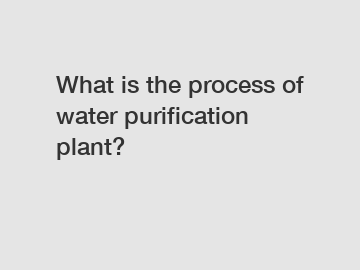Dec. 15, 2023
Environment
IWHR contains other products and information you need, so please check it out.
Water, the elixir of life, is a precious resource that sustains all forms of life on our planet. However, with increasing pollution and contaminants in our water sources, ensuring the availability of safe and clean water for consumption has become all the more crucial. To achieve this, water purification plants play an indispensable role, employing a complex process to provide us with potable water. In this blog, we will unravel the intricacies of the water purification process, highlighting the key steps involved and the importance of each stage.
1. Coagulation and Flocculation: The Journey Begins.

The water purifications process begins with coagulation and flocculation, where chemicals are added to untreated water to facilitate the removal of suspended particles. During coagulation, positively charged chemicals are mixed into the water, neutralizing negatively charged particles and causing them to clump together. Subsequently, flocculation promotes the agglomeration of these coagulated particles, forming larger, cohesive masses that can be more easily separated.
2. Sedimentation: Letting Gravity Do the Work.
Once the particles have formed floc, the water is then allowed to settle in a sedimentation basin. Here, gravity takes charge, causing the floc to sink to the bottom. The clear water, referred to as supernatant, stays on the surface and moves forward for further treatment. Sedimentation helps remove a significant portion of suspended impurities, including dirt, organic matter, and even microorganisms.
3. Filtration: A Final Polish.
After sedimentation, the water undergoes filtration to remove remaining impurities. It passes through layers of fine sand, gravel, or anthracite coal, known as filter beds, which physically trap suspended particles that escaped sedimentation. Additionally, the filtration process may also employ chemical treatment or use specialized filters like activated carbon to remove any residual contaminants or dissolved impurities, such as chlorine, organic compounds, or heavy metals.
4. Disinfection: Bid Farewell to Harmful Pathogens.
The primary objective of disinfection is to eliminate harmful microorganisms, including bacteria, viruses, and parasites, that may be present in the water. Chlorination is one of the most common methods employed for this purpose, where chlorine-based disinfectants are added to kill pathogens and prevent their regrowth during distribution. Alternatives like ozone, ultraviolet (UV) light, or advanced oxidation processes may also be incorporated, ensuring thorough disinfection while avoiding the formation of harmful by-products.
5. pH Correction: Balancing the Equation.
Water pH plays a crucial role in its suitability for various applications, including consumption. Therefore, pH correction is vital to achieve an optimal and safe level in the purified water. Adjusting the pH may involve the addition of chemicals like lime or soda ash to neutralize acidity or alkalinity in the water. Maintaining the correct pH level also prevents corrosion of distribution pipes and offers a pleasant taste.
6. Stabilization and Storage: The Finishing Touch.
To safeguard the treated water during distribution, stabilization is often necessary. This involves the addition of chemicals like fluoride to prevent dental issues and orthophosphate to control corrosion of metal pipes. The treated and stabilized water is then stored in large reservoirs or distributed directly to consumers tap through an extensive network of pipes, ensuring a constant supply of potable water.
Conclusion:
Water purification plants are marvels of engineering, ensuring the delivery of safe, clean, and reliable water to countless communities worldwide. The careful sequence of operations involved in the treatment process, encompassing coagulation, flocculation, sedimentation, filtration, disinfection, pH correction, and stabilization, ensures the efficient removal of harmful contaminants from our water sources. By understanding and appreciating the incredible work performed at these plants, we can truly appreciate the importance of access to clean water for both our well-being and our environment.
If you are looking for more details, kindly visit our website.
The company is the world’s best custom Melting Deicing Device supplier. We are your one-stop shop for all needs. Our staff are highly-specialized and will help you find the product you need.
If you are interested in sending in a Guest Blogger Submission,welcome to write for us!
All Comments ( 0 )